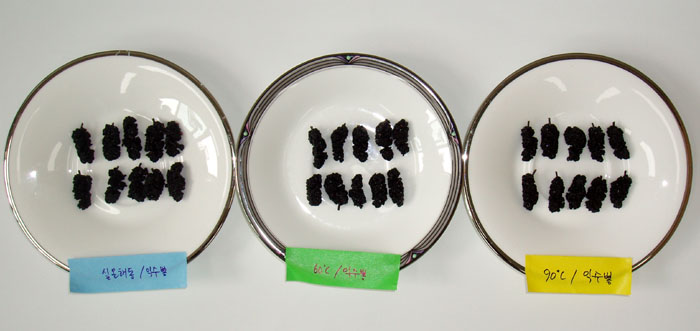A new method of making “semi-dried mulberries” has been discovered using honey and not causing any disfigurement.
The Rural Development Administration recently carried out a test with mulberries, in which the frozen fruits were defrosted at room temperature and then some of them were left in a hot-air drying machine for three hours at 60 degrees Celsius. In the meantime, others were left in the machine for two hours at 90 degrees Celsius.
The dried fruit was covered with some honey and then left again for 20 to 30 hours at 38 degrees Celsius. During that time, more honey, weighing as much as 10 to 30 percent of the individual fruits’ weight, was added. As a result, the honey served to prevent any disfigurement of the fruit, even under such hot temperatures, and instead added to the sweet taste of the fruit.

Compared to the existing method of drying, in which the mulberries are preserved in sugar for a month and then put in the drying machine, the new method is time-saving, as the job can be done in just one or two days. Any farmhouse with a hot-air dryer can now easily make honey-sweetened, semi-dried mulberries using this new technique.
Mulberries are known to be rich in essential amino acids, as well as in calcium, potassium, vitamin C and iron. They also have antioxidant effects, which may help lessen the results of aging.
“Mulberries don’t feel good in terms of texture after they're left for a long time at room temperature. In that state, the fruit can easily become too soft and doesn't taste good, as it becomes very dry,” said Kim Hyeon-bok, researcher at the Rural Development Administration.
“The mulberries that went through our new semi-drying process look a little dried from their appearance, but they retain their moisture inside, having a chewy texture that tastes really good. This new technique will, hopefully, increase consumption of the fruit, which will then lead to an increase in rural household incomes.”
By Sohn JiAe
Korea.net Staff Writer
Photo: the Rural Development Administration
jiae5853@korea.kr
The Rural Development Administration recently carried out a test with mulberries, in which the frozen fruits were defrosted at room temperature and then some of them were left in a hot-air drying machine for three hours at 60 degrees Celsius. In the meantime, others were left in the machine for two hours at 90 degrees Celsius.
The dried fruit was covered with some honey and then left again for 20 to 30 hours at 38 degrees Celsius. During that time, more honey, weighing as much as 10 to 30 percent of the individual fruits’ weight, was added. As a result, the honey served to prevent any disfigurement of the fruit, even under such hot temperatures, and instead added to the sweet taste of the fruit.

Half-dried mulberries are seen after they've gone through a drying process at 60 degrees Celsius (center) and at 90 degrees Celsius (right). They both retain a similar appearance to the unprocessed mulberries (left) with no disfiguration.
Compared to the existing method of drying, in which the mulberries are preserved in sugar for a month and then put in the drying machine, the new method is time-saving, as the job can be done in just one or two days. Any farmhouse with a hot-air dryer can now easily make honey-sweetened, semi-dried mulberries using this new technique.
Mulberries are known to be rich in essential amino acids, as well as in calcium, potassium, vitamin C and iron. They also have antioxidant effects, which may help lessen the results of aging.
“Mulberries don’t feel good in terms of texture after they're left for a long time at room temperature. In that state, the fruit can easily become too soft and doesn't taste good, as it becomes very dry,” said Kim Hyeon-bok, researcher at the Rural Development Administration.
“The mulberries that went through our new semi-drying process look a little dried from their appearance, but they retain their moisture inside, having a chewy texture that tastes really good. This new technique will, hopefully, increase consumption of the fruit, which will then lead to an increase in rural household incomes.”
By Sohn JiAe
Korea.net Staff Writer
Photo: the Rural Development Administration
jiae5853@korea.kr
Most popular
- Grammy-winning producer calls Suga of BTS 'amazing artist'
- 'Universal love, family' themes fuel success of 'King of Kings': director
- Council sets minimum hourly wage in 2026 at KRW 10,320
- Export deal for K2 tank concluded with Poland for KRW 9T
- Songs from animated K-pop film rule Spotify daily chart in US
